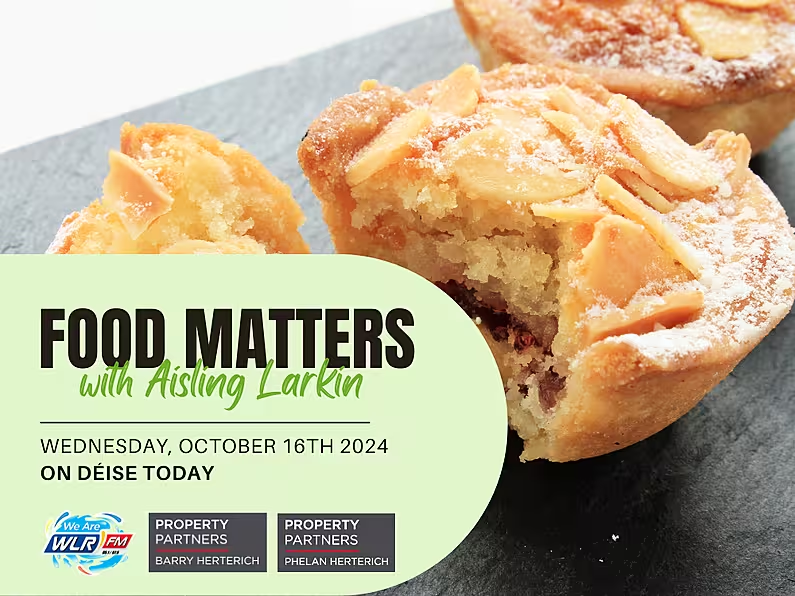In Episode 20 of Food Matters well-renowned Chef, TV Cook, and Food Media Broadcaster Aisling Larkin chats about October Baking including a Modern Barmbrack and also Apple and Raspberry Bakewell Tart
Food Matters is brought to you with thanks from Property Partners Barry Herterich and Property Partners Phelan Herterich who have offices in Tramore and Waterford City. With over 40 years combined experience both Barry and Deirdre bring a wealth of knowledge and experience in residential and commercial property, and we pride ourselves on our exceptional service, results-driven dedication, and our reputation for trustworthy, focused commitment to every client. With an emphasis on communication and integrity, we deliver expertise and success to all of our clients, presenting a bespoke service that always goes the extra mile.
Waterford City - Property Partners Phelan Herterich website HERE / Call 051-364052 / Connect on Facebook HERE
Tramore - Property Partners Barry Herterich website HERE / Call 051-330465 / Connect On Facebook HERE
October Baking: Modern Barmbrack & Apple and Raspberry Bakewell Tart
Barmbrack is a traditional Irish fruit bread that holds a special place in Halloween celebrations, particularly because of its history with the Celtic festival of Samhain. During Samhain, it was believed that the veil between the living and the dead was at its thinnest, and people would engage in rituals to predict the future. Barmbrack became central to this tradition as it often contained symbolic items, such as a ring for marriage, a coin for wealth, and a cloth for misfortune, making it a fun and mysterious part of the festivities.
The absence of fat in barmbrack is notable. Traditional Irish recipes often relied on simplicity, using basic, accessible ingredients. Barmbrack was typically made without butter or oil, which were considered luxuries. Instead, it focused on the sweetness and moisture of the dried fruits. This made it lighter than some richer cakes but still full of flavour, thanks to the spices and fruit infusion.
One of the key differences between barmbracks is whether they are yeast-based or cake-based. The yeast-based barmbrack resembles a bread in its texture—light, airy, and slightly chewy, with the yeast giving it a rise and a subtle tang. This method dates back to when yeast was more commonly used in home baking. The cake-based version, however, is denser and richer, often easier to make and more like a tea loaf, with a soft crumb. Both have their devotees, but the yeast version is considered more traditional.
Cold tea is often used in barmbrack to soak the dried fruits before baking. This practice was practical in an era when leftover tea wouldn’t be wasted, and it also serves an important culinary function. Soaking the fruit in cold tea not only plumps it up, making it juicier and more flavorful, but the tannins in the tea add an extra depth of flavour, giving the bread a unique complexity. It’s a simple, resourceful way to elevate a rustic recipe into something memorable.
Modern Barmbrack
350g dried fruit
100g raisins
100g dates
50g goji berries
50mls whiskey ( a honey-infused whiskey is lovely here )
50g dried apricots
175g brown sugar
50g dried figs
300ml cold tea
50g milled flaxseed, chia seed, Brazil nut combo
1 tsp vanilla extract
1 tsp mixed spice
225g Odlums self-raising flour
A modern barmbrack recipe using ingredients like dried dates, figs, raisins, goji berries, dried apricots, milled flaxseeds, and Brazil nuts offers enhanced nutritional benefits compared to a traditional recipe, which typically uses raisins, sultanas, and some sugar.
Here’s a breakdown of the benefits:
- Higher Fibre Content - Modern Ingredients: Dried fruits such as dates, figs, apricots, and flaxseeds are high in dietary fibre, which aids digestion, supports gut health, and helps regulate blood sugar levels. Flaxseeds are particularly high in soluble fibre. - Traditional Recipe: The fibre comes primarily from raisins and sultanas, offering a lower amount of fibre compared to the diverse blend of dried fruits and seeds in the modern version. ###
- Healthier Fats - Modern Ingredients: Brazil nuts and flaxseeds are rich in healthy fats, particularly omega-3 fatty acids (from flaxseeds) and monounsaturated fats (from Brazil nuts). These fats support heart health and reduce inflammation. Traditional Recipe: Traditional barmbrack doesn't typically include nuts, meaning it lacks these beneficial fats. ###
- Higher Antioxidant Content- Modern Ingredients* Goji berries, figs, and Brazil nuts are packed with antioxidants like vitamin C, selenium, and polyphenols. Antioxidants help protect the body from oxidative stress, reducing the risk of chronic diseases. Traditional Recipe: Raisins and sultanas have some antioxidants but not in the concentrated amounts found in goji berries and Brazil nuts.
- Increased Protein Modern Ingredients: Brazil nuts and flaxseeds contribute to the protein content, supporting muscle repair and overall body functions. This makes the modern barmbrack slightly higher in protein than the traditional version. Traditional Recipe: The protein content is lower, relying mainly on the small amount present in flour.
- Rich in Essential Micronutrients- Modern Ingredients: -Brazil nuts are an excellent source of selenium, which supports thyroid function and immunity. - **Flaxseeds** provide
Break The Rules, Bakewell,
- Butter or Margarine for pastry
- Do you need to rub it in by hand
- Do you need to bake it blind
- Do you need to roll out the pastry in flour
- Do you need to let it cool before you cut it
- Can you put a fruit in the middle
- Do you really need the almonds?
A Short History of Bakewell
It is made with shortcrust pastry filled with jam and frangipane and topped with flaked almonds
Marquis Muzio Frangipani
The history of frangipane is traced to a 16th-century Italian nobleman, Marquis Muzio Frangipani, who introduced almond perfume-scented gloves that were all the rage. Pastry chefs tried to capture this popular scent in desserts; hence the birth of frangipane.
The word frangipane is a French term used to name products with an almond flavour. The word comes ultimately from the last name of Marquis Muzio Frangipani or Cesare Frangipani.
Is Frangipane and Bakewell the same thing?
Why is it called a Bakewell tart?
Bakewell tart is named after the Derbyshire town of Bakewell, where the Bakewell pudding (later to evolve into the Bakewell tart) was first served in the (no longer standing) White Horse Inn. The exact date of its creation is unknown, but the recipe for Bakewell pudding first appeared in print in 1845, in a cookbook by Eliza Acton. It is thought that the recipe was modified sometime in the early 20th century to become Bakewell tart.
Bakewell tart tip!
Do not allow your oven to get too hot! This will cook the outside of the tart much quicker than the inside, resulting in either a burnt tart or an underbaked filling.
What are the ingredients in a Bakewell tart?
There are multiple ingredients in a Bakewell tart. The base tart is made from a shortcrust pastry of butter, flour, salt and water, then comes a layer of jam made from fruit (strawberries or raspberries) and sugar, then a layer of frangipane - made from butter, eggs, ground almonds, sugar, almond extract and some flour. The tart is topped with flaked almonds.
What’s the difference between Bakewell tart and frangipane?
Frangipane is not an alternative to Bakewell tart, but instead one of the ingredients in a Bakewell tart, used for the filling.
Bakewell tart tip!
Blind-bake the pastry tart shell before cooking with the filling, for a better crust texture.
What pastry is Bakewell tart made from?
Bakewell tart is made from shortcrust pastry, a crumbly buttery pastry made using the “shortening” method. Shortcrust pastry is made with butter (or some type of fat), flour (usually wheat), salt and water, with the ratio being 1 part fat to 4 parts flour.
Bakewell tart tip!
The filling of a Bakewell tart should be "just set". So take it out of the oven before it gets too firm.














